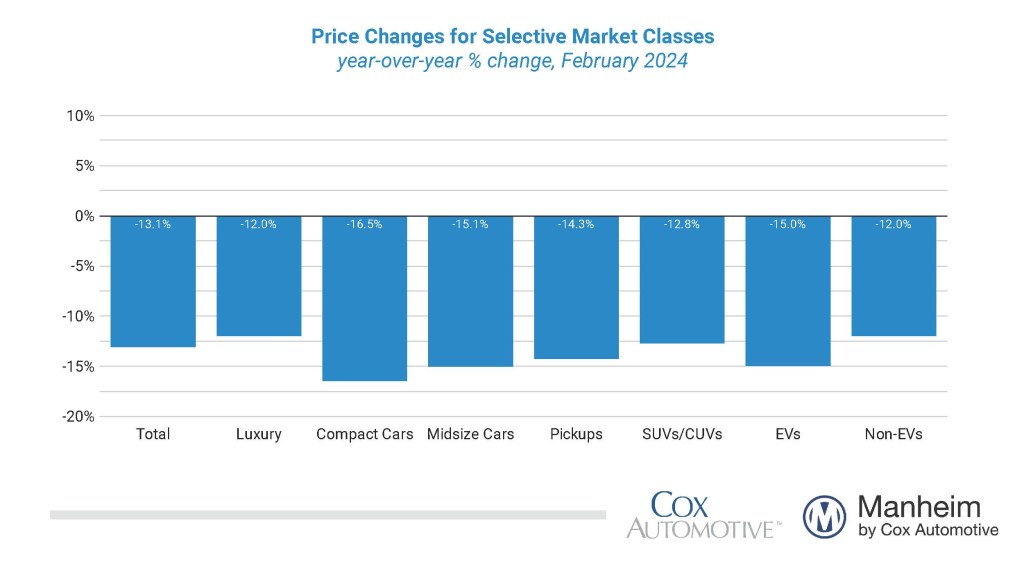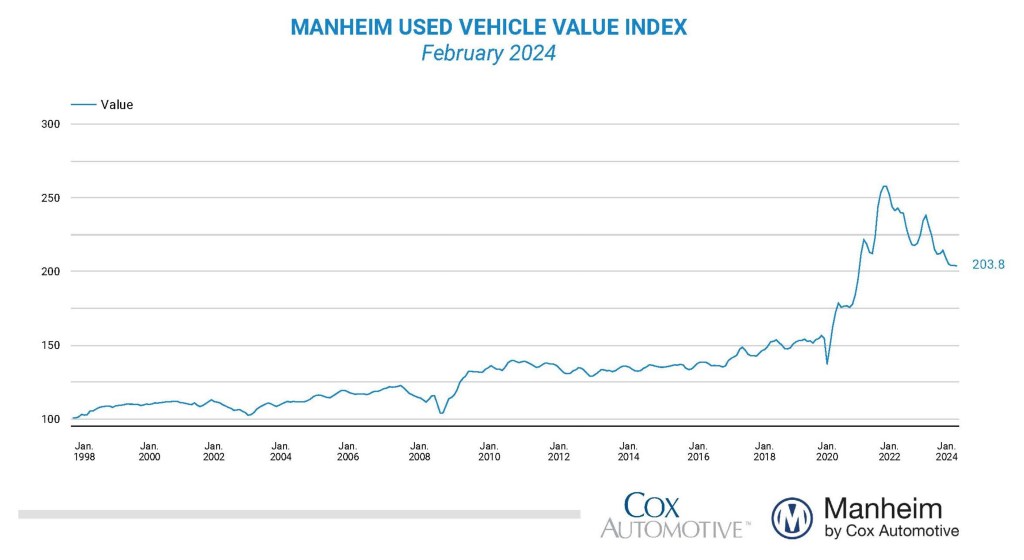Data Point
Wholesale Used-Vehicle Prices Declined in February
Thursday March 7, 2024
Wholesale used-vehicle prices (on a mix, mileage, and seasonally adjusted basis) were down in February compared to January. The Manheim Used Vehicle Value Index (MUVVI) fell to 203.8, a decline of 13.1% from a year ago. The index was down 0.1% against the month of January 2024. The seasonal adjustment magnified February’s results. The non-adjusted price in February increased by 1.7% compared to January, moving the unadjusted average price down 11.0% year over year.
“Though February activity was muted as we started the month, we saw more activity in the lanes at Manheim in the second half of the month and finished the last week of February with some of the strongest weekly gains in wholesale prices for many years,” said Jeremy Robb, senior director of Economic and Industry Insights for Cox Automotive. “Tax refunds have picked up over the last two weeks, with the average refund now 4% higher than 2023 levels at this time. This has put money into consumers’ pockets, and retail purchase activity is increasing. In turn, dealers are coming to the lanes and buying units at Manheim right at the start of the spring selling season for wholesale markets.”
In February, Manheim Market Report (MMR) values saw above-average weekly increases for most of the month and ended February on a high note. Over the last four weeks, the Three-Year-Old Index increased an aggregate of 1.6%, including a rise of 0.8% in the last week of the month. Those same four weeks delivered an average increase of 0.8% between 2014 and 2019. Over the month of February, daily MMR Retention, which is the average difference in price relative to the current MMR, averaged 99.9%, meaning market prices were just below MMR values but moved higher than January. The average daily sales conversion rate increased to 61.0%, which indicates that demand was improving relative to January, normal for this time of year. For comparison, the daily sales conversion rate averaged 58.6% in February during the last three years.
The major market segments saw seasonally adjusted prices that remained lower year over year in February. Compared to February 2023, luxury lost less than the industry, down just 12.0%, and SUVs performed a little better than the industry, declining 12.8%. Compact cars continued as the worst performers year over year, down 16.5%, followed by midsize cars, off by 15.1%, and pickups, down 14.3%. Compared to last month, trucks lost 1.4%, and compact cars were down 0.2%. Declining less than the market overall, midsize cars were up 0.8%, and both luxury and SUVs increased 0.3%.

With the increase in interest in electric vehicle (EV) values versus the non-EV market, we are working on sharing metrics for those segments. Seasonally adjusted EV values for February 2024 were down 15.0%, while non-EVs were down 12.0% year over year. If we look at values against last month, seasonally adjusted EV values increased 1.0% from January 2024, while non-EVs increased by 0.3% over the same period.
Used Retail Vehicle Sales Increased in February
Assessing retail vehicle sales based on observed changes in units tracked by vAuto, we initially estimate that used-vehicle retail sales in February were up 18% compared to January, while used retail sales are estimated to be up 5% year over year in February. The average retail listing price for a used vehicle declined 1.6% over the last four weeks.
Using estimates of used retail days’ supply based on vAuto data, an initial assessment indicates February ended at 46 days’ supply, down eight days from 54 days at the end of January but two days higher than how February 2023 ended at 44 days.
February’s total new-light-vehicle sales were up 9.6% year over year, with one more selling day than February 2023. By volume, February new-vehicle sales were up 16.6% month over month. The February sales pace, or seasonally adjusted annual rate (SAAR), came in at 15.8 million, an increase from last February’s 14.9 million pace and up significantly from January’s revised 14.9 million level.
Combined sales into large rental, commercial, and government fleets increased 21.4% year over year in February. Sales into rental fleets were up 46% year over year, sales into commercial fleets were down 4%, and sales into government fleets were up 1%. Including an estimate for fleet deliveries into dealer and manufacturer channels, the remaining retail sales were estimated to be up 8.8% from last year, leading to an estimated retail SAAR of 12.8 million, up 0.8 million from last year’s pace, and up from January’s 12.3 million level. Fleet share was estimated to be 20.0%, up slightly from last year’s 19.4% share.
Rental Risk Prices Mixed; Mileage Dropped Significantly in February
The average price for rental risk units sold at auction in February declined 9.1% year over year. Rental risk prices increased by 0.6% compared to January. Average mileage for rental risk units in February (at 46,700 miles) continues to be down compared to a year ago, declining by 23.1% against February 2023. Mileage for units in February was up 8.1% from January.
Most Measures of Consumer Confidence Saw Declines in February
The Conference Board Consumer Confidence Index® declined by 3.8% in February, as views of the present situation gave up some of January’s gains and views of the future also declined. Consumer confidence was up 3.2% year over year. Plans to purchase a vehicle in the next six months increased and were up substantially year over year. Consumer sentiment according to the sentiment index from the University of Michigan also declined in February. The Michigan index declined 2.7% for the month but was up 14.9% year over year. The median consumer expectation for inflation in a year increased to 3.0%, but the expectation for five years remained at 2.9%. The consumers’ view of buying conditions for vehicles increased to the highest level since July 2021 as views of prices and interest rates were less negative. The daily index of consumer sentiment from Morning Consult increased in February and left the index up 11.4% year over year. The divergence with the other two indices is likely related to the timing of when surveys are collected. All the indices are up so far in 2024. The daily index increased 2.8% from the end of January. Gas prices increased in February. According to AAA, the national average price for unleaded gasoline increased 5.7% to $3.33 per gallon as of Feb. 29, which was down 1% year over year.
The next complete suite of monthly MUVVI data will be released on April 5, 2024, the fifth business day of the month, as regularly scheduled. The Q1 MUVVI call will be held on April 5 at 11 a.m. EDT. Register to attend.
For questions or to request data, please email manheim.data@coxautoinc.com. If you want updates about the Manheim Used Vehicle Value Index, as well as direct invitations to the quarterly call sent to you, please sign up for our Cox Automotive newsletter and select Manheim Used Vehicle Value Index quarterly calls.
Note: The Manheim Used Vehicle Value Index was adjusted to improve accuracy and consistency across the data set as of the January 2023 data release. The starting point for the MUVVI was adjusted from January 1995 to January 1997. The index was then recalculated with January 1997 = 100, whereas prior reports had 1995 as the baseline of 100. All monthly and yearly percent changes since January 2015 are identical. Learn more about the decision to rebase the index.

